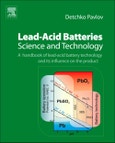Lead-Acid Batteries: Science and Technology presents a comprehensive overview of the theory of the technological processes of lead-acid battery manufacture and their influence on battery performance parameters. It summarizes the current knowledge about the technology of lead-acid battery production and presents it in the form of an integral theory. This theory is supported by ample illustrative material and experimental data, thus allowing technologists and engineers to control the technological processes in battery plants and providing university lecturers with a toll for clear and in-depth presentation of the technology of lead-acid battery production in their courses. The relationship between the technological processes and the performance characteristics of the batteries is disclosed too.
Automotive Lead Acid Battery Market Report: Trends, Forecast and Competitive Analysis to 2031
- Report
- 150 Pages
- Global








